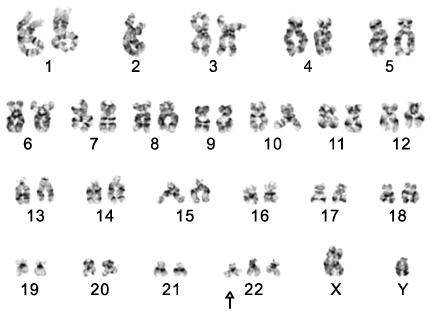Ewha Med J.
2012 Mar;35(1):62-64. 10.12771/emj.2012.35.1.62.
Sole Trisomy 22 Not Associated with inv(16) in Myelodysplastic Syndrome
- Affiliations
-
- 1Department of Laboratory Medicine, Ewha Womans University School of Medicine, Seoul, Korea. JungWonH@ewha.ac.kr
- 2Department of Internal Medicine, Ewha Womans University School of Medicine, Seoul, Korea.
- KMID: 2134949
- DOI: http://doi.org/10.12771/emj.2012.35.1.62
Abstract
- Trisomy 22 is closely associated with inv(16) or t(16;16) and could be a marker of cryptic rearrangement of CBFB/MYH11 in acute myeloid leukemia (AML). Trisomy 22 not associated with CBFB/MYH11 rearrangement is a rare event. Here, we report a case diagnosed as refractory anemia with excess blasts-2 (RAEB-2) with sole trisomy 22 in the absence of CBFB/MYH11 rearrangement. The cytogenetic study of bone marrow cells disclosed trisomy 22 in 10% of metaphase cells analyzed. The other chromosomal abnormalities were not found. Fluorescence in situ hybridization (FISH) using CBFB/MYH11 probe to detect cryptic inv(16)(p13q22) showed negative result. We also excluded rearrangements of chromosome 5, 7, 8, 20, and ETV6 by FISH. Sole trisomy 22 not associated with inv(16) is a true entity.
Keyword
MeSH Terms
Figure
Reference
-
1. Bilhou-Nabera C. Huret JL, editor. del(20q) in myeloid malignancies. Atlas of genetics and cytogenetics in oncology and haematology [Internet]. 2000. cited 2012 Feb 10. Poitiers: Genetics DIM, University Hospital;Available from: http://AtlasGeneticsOncology.org/Anomalies/del20qID1040.html.2. Swerdlow SH, Campo E, Harris NL, Jaffe ES, Pileri SA, Stein H, et al. WHO classification of tumours of haematopoietic and lymphoid tissues. 2008. 4th ed. Lyon: International Agency for Research on Cancer.3. Takahashi T, Harada S, Oki M, Yoshimoto M, Tsujisaki M. Trisomy 22 as the sole karyotypic abnormality in myelodysplastic syndrome. Int J Hematol. 2005. 81:269–270.4. Gozzetti A, Calabrese S, Crupi R, Tozzuoli D, Bocchia M, Fabbri A. Trisomy 22 as sole cytogenetic abnormality in acute monoblastic leukemia (M5b). Cancer Genet Cytogenet. 2006. 169:86.
- Full Text Links
- Actions
-
Cited
- CITED
-
- Close
- Share
- Similar articles
-
- Trisomy 9, As a Sole Chromosomal Aberration in Refractory Anemia with Excess Blasts-II
- Cytogenetic Findings in Patients with Acquired Aplastic Anemia
- Anesthetic experience for laparoscopic cholecystectomy in a patient with myelodysplastic syndrome with trisomy 8 mosaicism syndrome
- A Case of Behcet's Disease Associated with Schizophrenia and Myelodysplastic Syndrome with Trisomy 8 and 9
- Repetitive Pregnancy Loss in inv(22)(p13q12) Carrier


